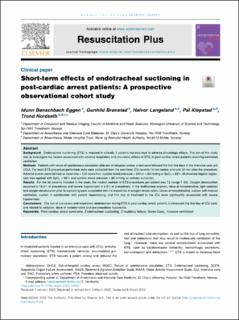| dc.contributor.author | Eggen, Idunn Banschbach | |
| dc.contributor.author | Brønstad, Gunhild | |
| dc.contributor.author | Langeland, Halvor | |
| dc.contributor.author | Klepstad, Pål | |
| dc.contributor.author | Nordseth, Trond | |
| dc.date.accessioned | 2023-03-02T10:29:23Z | |
| dc.date.available | 2023-03-02T10:29:23Z | |
| dc.date.created | 2022-04-27T09:16:05Z | |
| dc.date.issued | 2022 | |
| dc.identifier.citation | Resuscitation Plus. 2022, 10 1-9. | en_US |
| dc.identifier.issn | 2666-5204 | |
| dc.identifier.uri | https://hdl.handle.net/11250/3055272 | |
| dc.description.abstract | Background Endotracheal suctioning (ETS) is required in critically ill patients but may lead to adverse physiologic effects. The aim of this study was to investigate risk factors associated with adverse respiratory and circulatory effects of ETS, in post-cardiac arrest patients receiving controlled ventilation. Methods Patients with return of spontaneous circulation after out-of-hospital cardiac arrest were followed the first five days in the intensive care unit (ICU). For each ETS procedure performed, data were extracted from the electronic ICU records 10 min before and until 30 min after the procedure. Adverse events were defined as heart rate > 120 beats/min, systolic blood pressure > 200 or < 80 mmHg or SpO2 < 85%. Multivariate logistic regression was applied with SpO2 < 85% and systolic blood pressure < 80 mmHg as primary outcomes. Results For the 36 patients included in the study, the median number of ETS-procedures per patient was 13 (range 1–33). Oxygen desaturation occurred in 10.3% of procedures and severe hypotension in 6.6% of procedures. In the multivariate analysis, dose of noradrenaline, light sedation and oxygen desaturation prior to suctioning were associated with increased risk of oxygen desaturation. Doses of noradrenaline, suction with manual ventilation, suction in combination with patient repositioning, and first day of treatment in the ICU were significantly associated with severe hypotension. Conclusions The risk of circulatory and respiratory deterioration during ETS in post-cardiac arrest patients is increased the first day of ICU care, and related to sedation, dose of noradrenaline and pre-procedure hypoxemia. | en_US |
| dc.language.iso | eng | en_US |
| dc.publisher | Elsevier | en_US |
| dc.relation.uri | https://www.sciencedirect.com/science/article/pii/S2666520422000212 | |
| dc.rights | Navngivelse 4.0 Internasjonal | * |
| dc.rights.uri | http://creativecommons.org/licenses/by/4.0/deed.no | * |
| dc.title | Short-term effects of endotracheal suctioning in post-cardiac arrest patients: A prospective observational cohort study | en_US |
| dc.title.alternative | Short-term effects of endotracheal suctioning in post-cardiac arrest patients: A prospective observational cohort study | en_US |
| dc.type | Peer reviewed | en_US |
| dc.type | Journal article | en_US |
| dc.description.version | publishedVersion | en_US |
| dc.source.pagenumber | 1-9 | en_US |
| dc.source.volume | 10 | en_US |
| dc.source.journal | Resuscitation Plus | en_US |
| dc.identifier.doi | 10.1016/j.resplu.2022.100221 | |
| dc.identifier.cristin | 2019358 | |
| cristin.ispublished | true | |
| cristin.fulltext | original | |
| cristin.qualitycode | 1 | |

